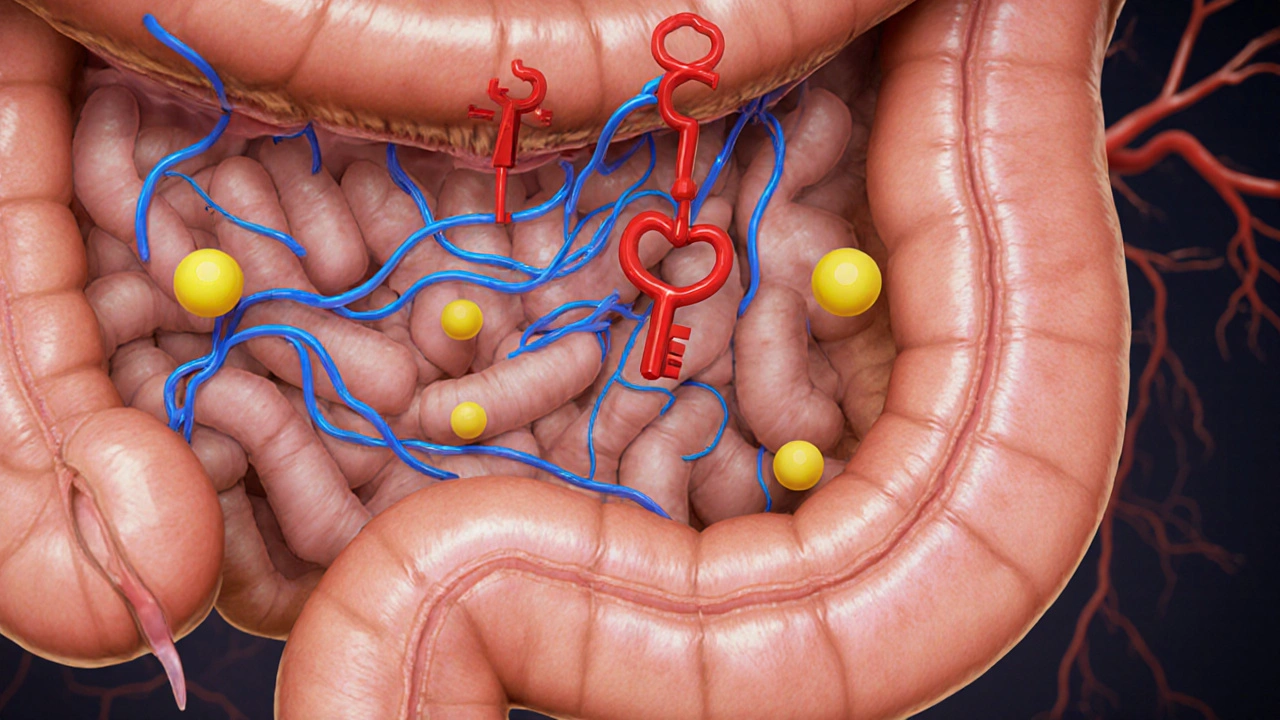Precose (Acarbose) vs Other Diabetes Drugs: In‑Depth Comparison
 Oct, 7 2025
Oct, 7 2025
Precose vs. Other Diabetes Drugs Comparison Tool
Recommended Treatment Option
Drug Comparison Overview
Precose (Acarbose)
Class: Alpha-Glucosidase Inhibitor
Works By: Slows carbohydrate absorption in the gut
Best For: Controlling post-meal blood sugar spikes
Side Effects: Flatulence, abdominal pain, diarrhea
Renal Safety: Safe with mild renal impairment
Metformin
Class: Biguanide
Works By: Reduces liver glucose production and improves insulin sensitivity
Best For: First-line treatment for type 2 diabetes
Side Effects: GI upset, potential lactic acidosis
Renal Safety: Contraindicated with severe renal impairment
Miglitol
Class: Alpha-Glucosidase Inhibitor
Works By: Similar to acarbose, blocks carbohydrate breakdown
Best For: Alternative to acarbose with potentially fewer GI issues
Side Effects: Flatulence, abdominal discomfort
Renal Safety: Same as acarbose
GLP-1 Receptor Agonist
Class: Incretin Mimetic
Works By: Delays gastric emptying and suppresses appetite
Best For: Weight loss and improved glucose control
Side Effects: Nausea, vomiting, injection site reactions
Renal Safety: Generally safe with normal kidney function
When managing post‑meal blood sugar, Precose (acarbose) is an alpha‑glucosidase inhibitor that slows carbohydrate absorption in the gut. It’s widely prescribed for type2 diabetes, especially when doctors want to curb spikes after meals. But is it the right choice for you, or would another drug work better? Below we break down how Precose stacks up against the most common alternatives, so you can decide based on efficacy, safety, cost, and lifestyle fit.
Key Takeaways
- Precose targets carbohydrate breakdown, delivering modest HbA1c reductions (≈0.5‑1.0%).
- Metformin remains the first‑line option for most patients because of greater efficacy and lower cost.
- Miglitol and voglibose are structurally similar to acarbose but differ in dosing frequency and GI tolerability.
- For patients who can’t tolerate metformin or need extra post‑prandial control, an alpha‑glucosidase inhibitor or a GLP‑1 agonist may be a better add‑on.
- Consider your kidney function, stomach sensitivity, and insurance coverage before picking a drug.
What Is Precose (Acarbose)?
Acarbose is the generic name for Precose, a prescription tablet approved in 1995. It belongs to the alpha‑glucosidase inhibitor class, which includes miglitol and voglibose. The drug works right in the small intestine, blocking the enzyme that breaks down complex carbs into glucose. Because the sugars are released more slowly, the post‑meal blood‑glucose rise is blunted.
How Does Precose Work?
The enzyme alpha‑glucosidase sits on the brush border of the small bowel. When you eat carbs, the enzyme chops them into simple sugars that can be absorbed. Precose binds to the enzyme’s active site, acting like a key that doesn’t turn, so the carbohydrate remains partially intact. This means:
- Glucose enters the bloodstream later, flattening the post‑prandial spike.
- Insulin demand after meals drops, easing pressure on pancreatic beta cells.
- Overall HbA1c can fall by roughly 0.5-1.0% when combined with diet and exercise.
Because the drug works in the gut, it isn’t filtered by the kidneys, making it a viable option for patients with mild renal impairment.
Major Alternatives to Precose
Below are the most frequently prescribed drugs that patients consider instead of acarbose.
- Metformin - a biguanide that reduces hepatic glucose production and improves insulin sensitivity.
- Miglitol - another alpha‑glucosidase inhibitor, taken three times daily.
- Voglibose - similar mechanism, usually taken before each main meal.
- DPP‑4 inhibitors (e.g., sitagliptin) - increase incretin levels to boost insulin release.
- GLP‑1 receptor agonists (e.g., liraglutide) - delay gastric emptying and reduce appetite.
Side‑Effect Profile: Precose vs. Alternatives
The biggest difference among these drugs is how the body tolerates them.
| Drug | GI Issues | Weight Impact | Risk of Lactic Acidosis | Renal Considerations |
|---|---|---|---|---|
| Precose (acarbose) | Flatulence, abdominal pain, diarrhea (dose‑dependent) | Neutral | None | Safe up to eGFR≥30mL/min |
| Metformin | Mild GI upset (often resolves with gradual titration) | Modest weight loss | Low but present; contraindicated if eGFR<30mL/min | Requires dose reduction if eGFR30‑45mL/min |
| Miglitol | Similar to acarbose but often milder | Neutral | None | Safe in mild renal impairment |
| Voglibose | Flatulence, nausea | Neutral | None | Safe, limited data in severe CKD |
| DPP‑4 inhibitors | Rare GI upset | Weight neutral | None | Generally safe; dose adjust for severe renal disease |
| GLP‑1 agonists | Nausea, vomiting (initial weeks) | Weight loss (2‑5kg) | None | Use with caution in severe renal impairment |
Efficacy Comparison: How Much Does Each Drug Lower HbA1c?
Clinical trials give us a ballpark:
- Metformin: 1.0‑1.5% reduction.
- Precose (acarbose): 0.5‑1.0% reduction, strongest when meals are high‑carb.
- Miglitol: 0.5‑0.8% reduction.
- Voglibose: 0.4‑0.7% reduction.
- DPP‑4 inhibitors: 0.5‑0.8% reduction.
- GLP‑1 agonists: 0.8‑1.4% reduction plus weight loss.
So, if you need the biggest HbA1c drop, metformin or a GLP‑1 agonist usually wins. Precise targeting of post‑meal spikes, however, is where acarbose shines.
Cost and Accessibility
In South Africa and many other markets, the price picture looks like this (average monthly cost, private‑pay):
- Metformin - R150‑R300 (generic tablets).
- Precose - R800‑R1200 (brand name); generic acarbose a bit cheaper.
- Miglitol - R1000‑R1500.
- Voglibose - R900‑R1300.
- DPP‑4 inhibitors - R2000‑R3500.
- GLP‑1 agonists - R4000‑R6000 (injectables).
If budget is a major factor, metformin is hard to beat. Precose becomes attractive only when a patient’s primary problem is post‑prandial spikes and they can tolerate the GI side effects.

Which Drug Fits Which Patient?
Below is a quick decision matrix.
| Patient Profile | First‑Line Choice | When to Add/Swap |
|---|---|---|
| Newly diagnosed, overweight, eGFR>60mL/min | Metformin | Add Precose if post‑meal spikes persist |
| Intolerant to metformin (GI upset) | Precise (acarbose) or miglitol | Consider GLP‑1 agonist if weight loss needed |
| Renal impairment (eGFR30‑45mL/min) | Acarbose (Precose) - safe | Avoid metformin; use DPP‑4 if needed |
| High carbohydrate diet, cultural meals rich in starch | Precose or voglibose (pre‑meal) | Combine with metformin for dual action |
| Need weight loss + glucose control | GLP‑1 agonist | Metformin can be added; avoid acarbose unless GI tolerable |
Practical Tips for Using Precose Effectively
- Start low (25mg three times daily) and increase weekly to the target dose (100mg three times daily) to limit flatulence.
- Take each dose with the first bite of a meal; missing a dose can lead to a sudden glucose rise.
- Pair with a low‑glycemic‑index diet. The drug works best when carbs are spread evenly.
- Monitor fasting and post‑prandial glucose for the first two weeks; adjust dose if spikes persist.
- If diarrhea is severe, try a probiotic or a short course of loperamide, but discuss with your clinician.
When Precose Is Not the Right Choice
If you experience any of the following, discuss alternatives with your doctor:
- Chronic severe diarrhea that leads to dehydration.
- History of inflammatory bowel disease (ulcerative colitis, Crohn’s).
- Pregnancy - most guidelines favor metformin or insulin.
- Need for rapid HbA1c reduction (<1% needed in <3months).
Frequently Asked Questions
Can I take Precose with metformin?
Yes. Many clinicians prescribe metformin as the base drug and add Precose to blunt post‑meal spikes. Start Precose at a low dose to see how your stomach handles the combination.
How quickly does Precose start working?
Because it acts in the gut, the effect begins with the first meal you take it with. However, noticeable changes in HbA1c typically require 8‑12 weeks of consistent use.
Is Precose safe for people with kidney disease?
Acarbose is not cleared by the kidneys, so it can be used down to an eGFR of about 30mL/min. Always check with your doctor for dose adjustments.
What should I do if I get too much gas on Precose?
Gradually increase the dose, split the total daily dose into three smaller pills, or try a probiotic. If symptoms persist, your doctor may switch you to miglitol or another class.
Does Precose cause weight gain?
No, weight change is generally neutral. Any weight gain often comes from excess calories, not the drug itself.

Alisa Hayes
October 7, 2025 AT 15:07While the overview of Precose covers the basics well, it’s worth noting that the drug’s efficacy can be highly dependent on patient diet. If a person consumes a lot of simple sugars, the post‑prandial benefit may be muted. Also, titrating the dose gradually can spare many users the dreaded flatulence. Keep an eye on kidney function, especially in older adults, because even mild impairment can influence dosing decisions.
Mariana L Figueroa
October 15, 2025 AT 17:53Start low and increase weekly to avoid gut upset.
mausumi priyadarshini
October 23, 2025 AT 21:43It’s curious, however, that the article glosses over the fact that alpha‑glucosidase inhibitors, including acarbose, can interfere with the absorption of certain nutrients, such as vitamin B12, which may lead to subtle deficiencies over time, especially in patients who already have borderline nutritional status, and this point deserves more emphasis, because neglecting it could result in clinicians overlooking an important aspect of long‑term management.
Carl Mitchel
November 1, 2025 AT 01:00Even though the side‑effects are often labeled “minor,” we have a moral obligation to inform patients that persistent diarrhea can lead to dehydration, which is especially dangerous for those with cardiovascular comorbidities. Ignoring this risks compromising patient safety and undermines informed consent.
Suzette Muller
November 9, 2025 AT 04:33From a practical standpoint, pairing Precose with a low‑glycemic diet can really amplify its benefits. I’ve seen patients who carefully time the dose with the first bite of a meal experience smoother glucose curves. It’s also helpful to advise them to keep a food diary to track carbohydrate intake alongside medication timing.
Josh SEBRING
November 17, 2025 AT 08:23But why bother with a diary? Just eyeball your meals and take the pill anyway, the body will sort it out, right? If you’re already on metformin, adding Precose is just adding more pills for no reason.